

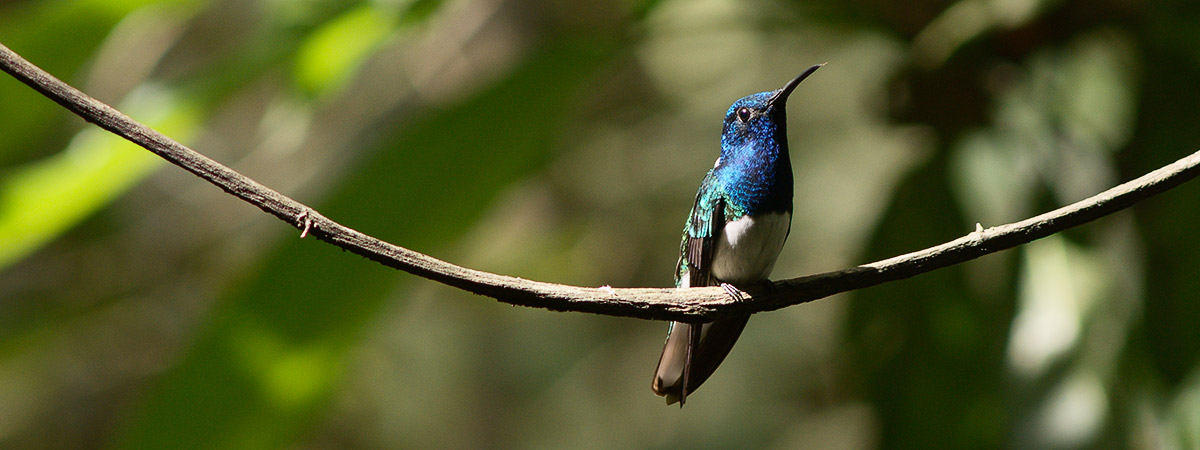

Perhaps Panama's most famous birding destination, Pipeline Road, is one of many trails inside Soberania National Park, which was established in 1980 and measures 48,287 acres (19,541 hectares).
The trail begins slightly north of Gamboa, home of the Panama Canal's Dredging and Maintenance Divisions. It measures approximately 10.5 miles (17 km), though most visitors don't venture far beyond the entrance to the Rainforest Discovery Center.
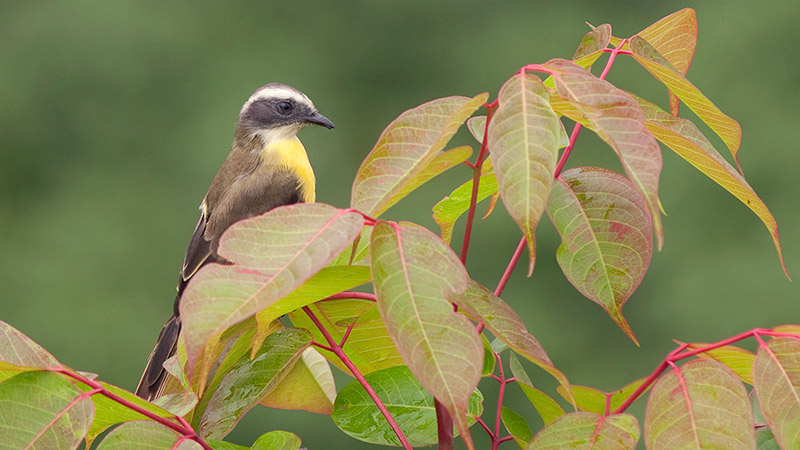
Pipeline Road – I photographed this bird on the outskirts of Pipeline Road, where there was more open space. Getting a clear shot like this along Pipeline Road is impossible, though you can obtain close-ups if you have a long lens.
At the entrance to Pipeline Road, you'll see an abandoned ranger station off to the right, as you see here. If arriving by vehicle, there is ample space off to the right where you can park and leave your vehicle. If you are participating in a cruise ship excursion, you will likely be transported directly to the Rainforest Discovery Center.
The road is well-maintained, composed primarily of dirt and stones, and wide enough to accommodate vehicular traffic. Dense verdant rainforest lines both sides of the trail, so there aren't any expansive views, though the overhead area is usually open. The road is mostly flat, with gradual inclines and declines and absent steep ascents and descents. It is easy, low-impact walking, especially during the dry season between November - May. During the rainy season and after a hard rain, you will find a few deep puddles and mud, but those are isolated occurrences. The drainage is excellent, and most often, the road is dry. Regardless, I highly recommend hiking shoes or sneakers — not sandals.
Due to the dense foliage, the trail is very dark during the early morning hours. Sunlight doesn't spatter the road until 7:30 at the earliest, and it isn't until 8:30-9:00 that the sun rises high enough to illuminate portions of the trail. Even then, the path is uniformly dim. But, the early morning and late afternoon lighting presents dramatic photographic opportunities as the sunlight pierces through and blankets the road and sections of the rainforest.
From the entrance, it should take 25-30 minutes to reach the turnoff for the Rainforest Discovery Center if all you are doing is walking. But it depends on how quickly you walk and how much time you spend on bird, animal, and plant viewing. It could take hours! You might never get there!
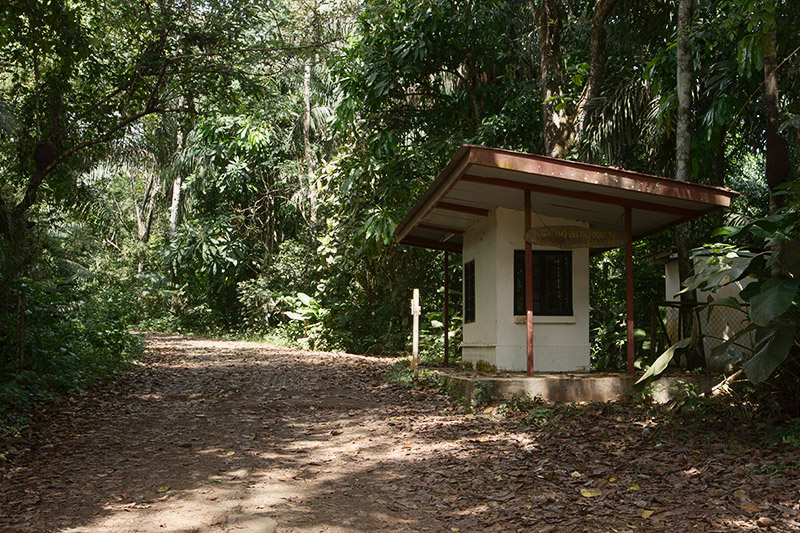
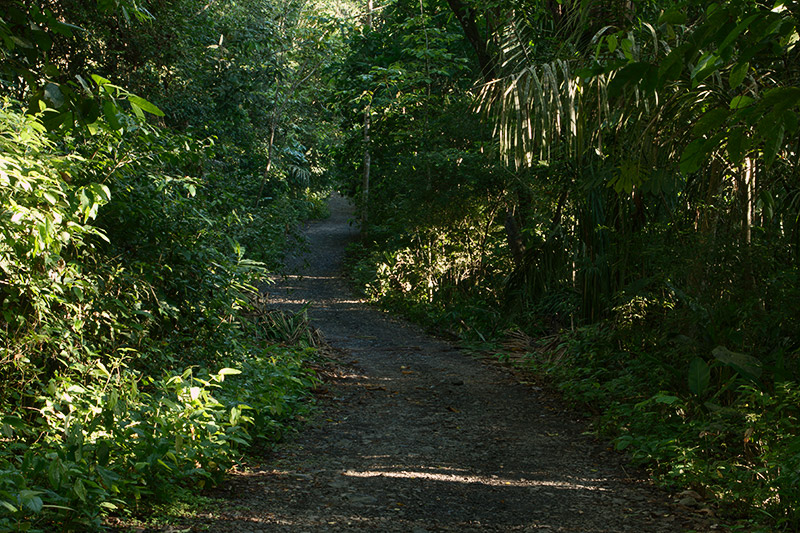

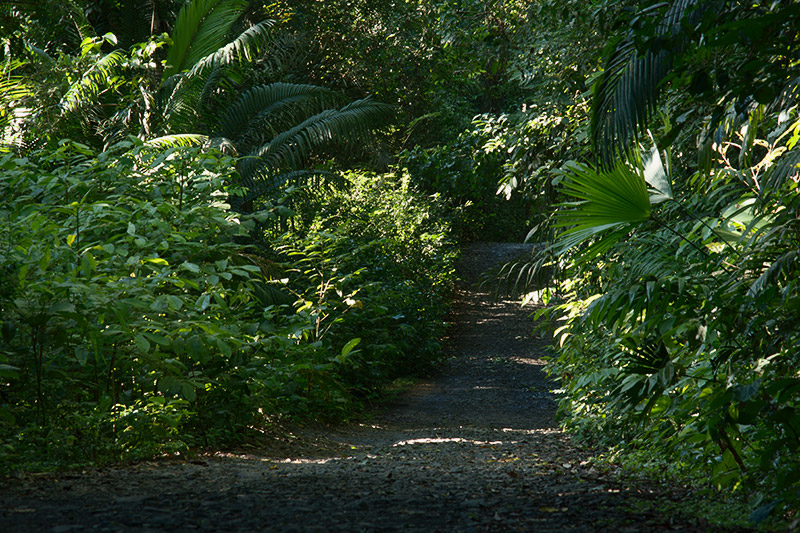
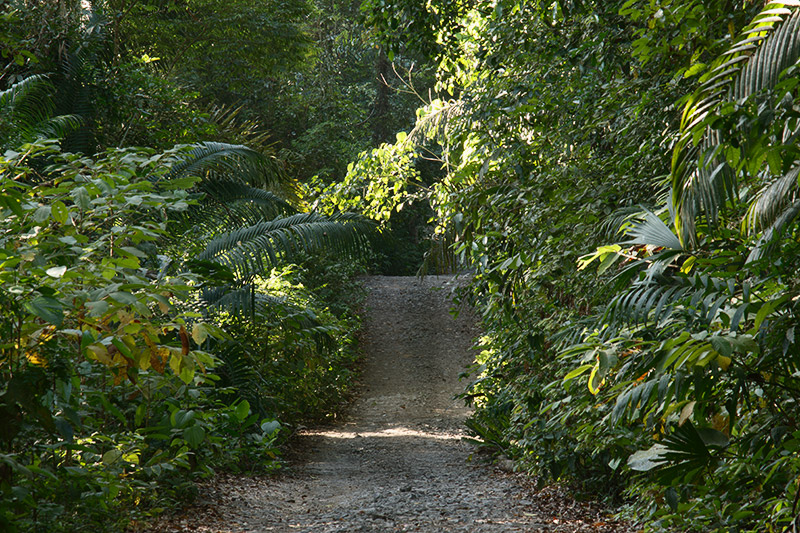

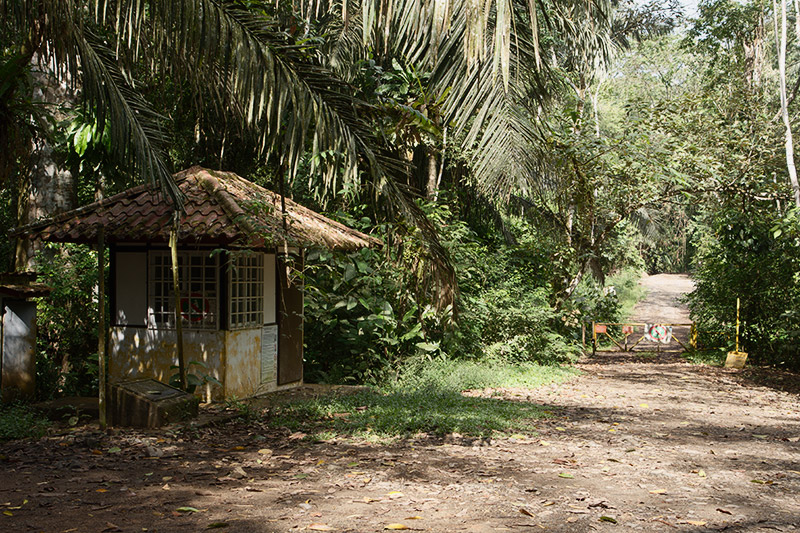
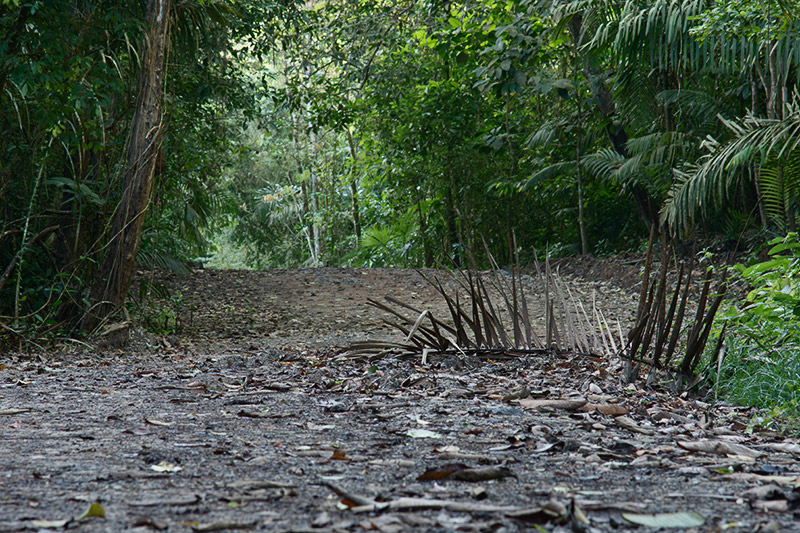
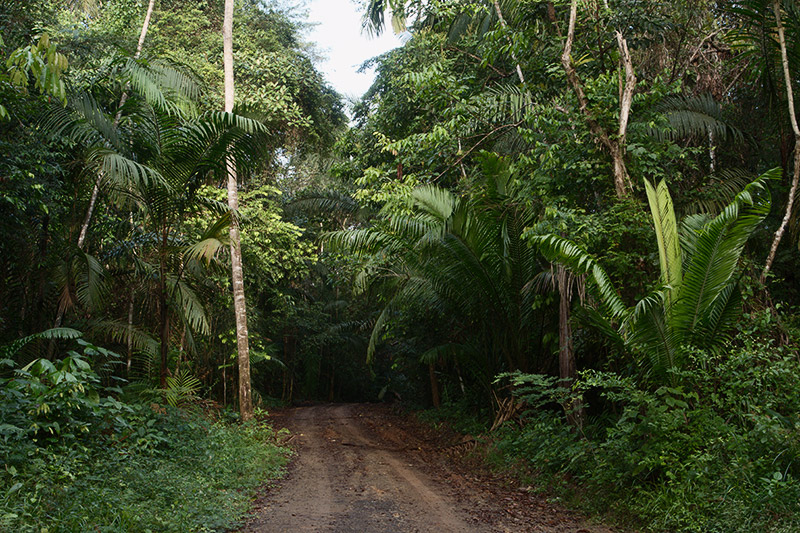
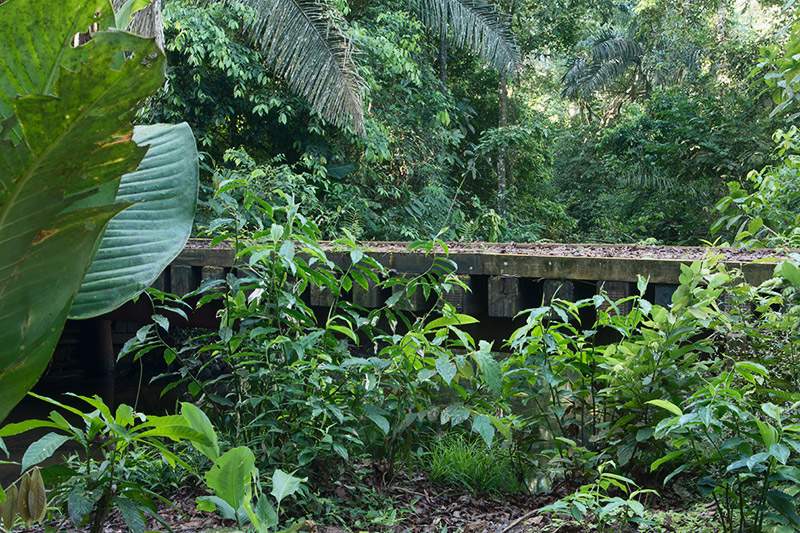
Pipeline Road continues well beyond the Rainforest Discovery Center but is less popular. The road gradually descends until it reaches a yellow steel gate; vehicles are prohibited from this point onward. Off to the left is a small abandoned ranger station.
You must walk around the left side of the gate to pass, and immediately following the gate is a sturdy wooden bridge. The shallow river passing under the bridge is the only place along Pipeline Road where I've seen basilisk (Jesus Christ) lizards, which weren't very large.
This portion of Pipeline Road is noticeably more expansive, with parts wide enough to handle two-way traffic. The tree growth on both sides of the road is less dense and further removed, allowing more light to penetrate and blanket the trail. As a result, it is better lit. However, a few areas closely resemble the initial section of Pipeline Road and are perhaps even narrower. In addition, the ascents and descents are more pronounced, but walking is never strenuous.
A second intersection is approximately 10 minutes from the wooden bridge/gate. On the left is a weathered red, octagon-shaped sign that reads "Radio Hill." With a maximum height of 413 ft (126 m), Radio Hill is, by far, the highest accessible spot along Pipeline Road that I have seen. Unfortunately, it doesn't provide panoramic views of the neighboring hillside or Panama Canal.
The road, wide enough to accommodate vehicular traffic but narrower than Pipeline Road, wastes no time commencing its steep upward trajectory. And it's noticeably darker. The road is composed primarily of dirt and rocks, but large sections, particularly near the top, are covered in asphalt. At the summit, the road splits in two, and while the path to the left continues a bit further, there's nothing to see.
I've only met a few birders on Radio Hill. With Pipeline Road so flat, easy to walk, and replete with birdlife, only enthusiastic explorers tackle Radio Hill. Furthermore, with vehicular traffic prohibited beyond the gate, it's a longer walk, complicated if carrying cumbersome photographic gear.
Remember, wildlife tends to be more active and visible during the early morning and late afternoon hours, compounding existing problems. During midday, the animals seek shade, making it even more difficult. It's an arduous task. And recognize that this is a natural park, not a zoo. The weather conditions and viewing opportunities change constantly. One minute, you might feel overjoyed, and the next, disillusioned. Patience and persistence are key.
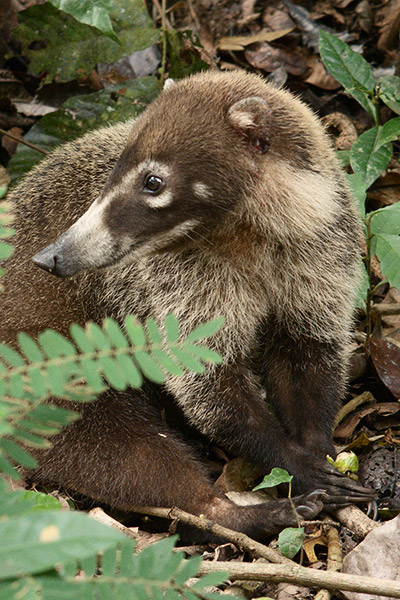
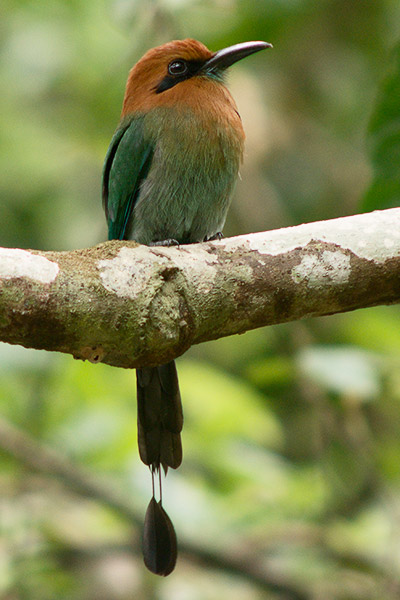
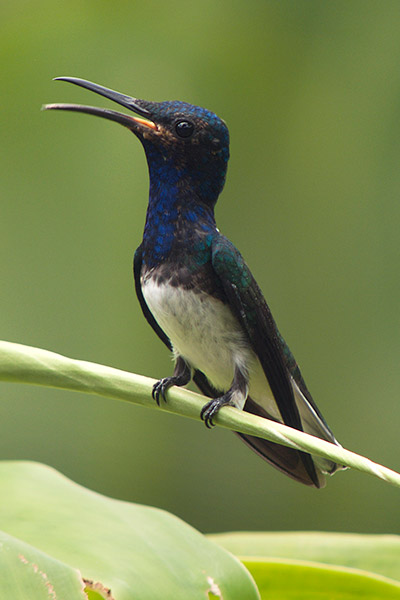
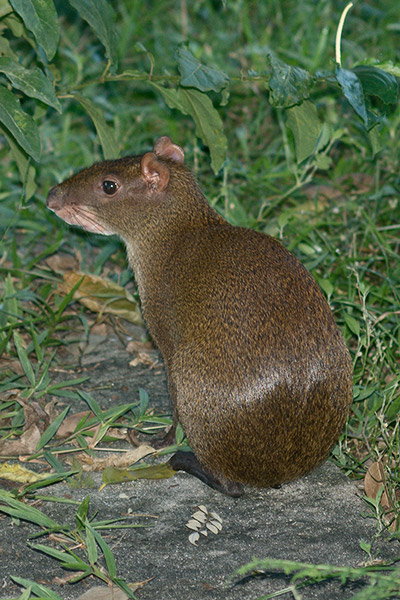
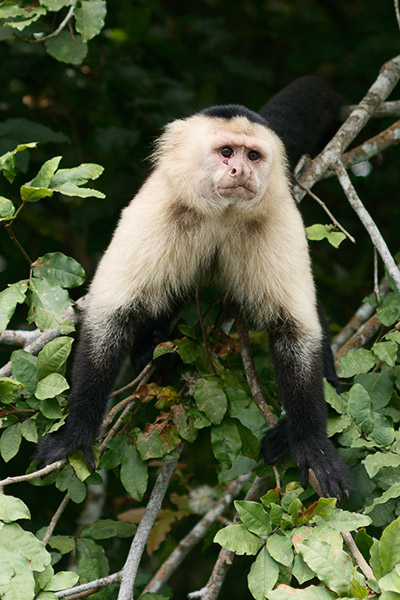
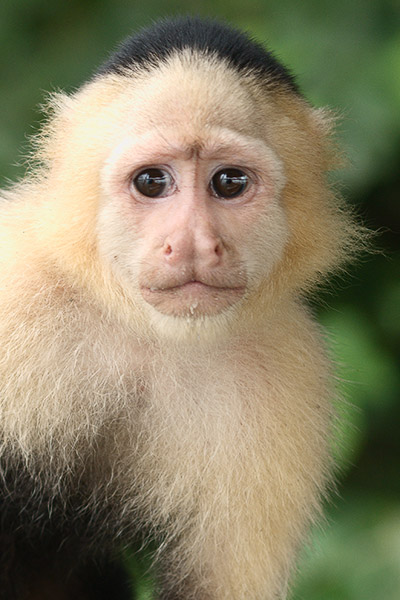
Professional guides accompany most birdwatchers I encounter on Pipeline Road. Some arrive in private birding groups, others on tours arranged through local hotels. They all have high-quality binoculars, and some possess scopes mounted on tripods.
With a knowledgeable guide, you should have no difficulty spotting wildlife. Most of the birders I speak with couldn't be happier. If you want to get the most out of your visit, hire a guide! I can't stress that enough.
The raucous outbursts of howler monkeys, the steady thumping of woodpeckers, and the screeching of parakeets are commonplace, but locating them is difficult. Sounds emanate from every nook and cranny of the rainforest, and you'll see nothing without knowing where to look. Many guides have sound speakers to attract birds, increasing your chances of spotting something.
Viewing wildlife and capturing still photographs are entirely different endeavors. Pipeline Road is an unusually challenging environment to shoot in, and I rarely stumble on dedicated photographers, except those taking pictures of hummingbirds at the Rainforest Discovery Center. Whether birds, monkeys, or sloths, the canopy is dense, rendering it dark even during daylight hours. The branches, trunks, and leaves make it almost impossible to isolate constantly moving subjects. And to make matters worse, you'll most often shoot upward against a dark background and bright, sunlit sky. Unfortunately, Pipeline Road provides no eye-level views of the canopy. For that, you'll need to visit the Rainforest Discovery Center.
It's common to hear howler monkeys roaring and see them branch-hopping, but they tend to remain high in the canopy and are challenging to photograph. White-faced capuchin monkeys, which often descend to lower elevations and are far more approachable, are not a common sighting. I have not seen any during my multiple visits to the Discovery Center or while hiking along Pipeline Road.
While a long, fast prime lens will help, it is no guarantee. I recommend a 400mm+ lens or longer. I know guides and photographers with 200-500mm zooms who almost always shoot at 500mm. A monopod and a camera body or lens with image stabilization will prove invaluable. You will find a tripod too restrictive and noisy to work with; it will definitely slow you down. A good pair of binoculars is the most common optic I see. Whether in the main building, atop the observation tower, or standing on the platform overlooking Lake Calamito, they will come in handy. I wouldn't visit without them.
Pipeline Road is not for the macro enthusiast, but for those interested, a 90mm lens, flash, and tripod should suffice, though if shooting handheld, you can discard the latter.
You won't find colorful plant species, e.g., heliconias, orchids, bougainvillea, etc. Most ferns, plants, and trees exhibit varying shades of green. I haven't seen many iguanas, anoles, spiders, frogs, or snakes. You will find mushrooms and moss on the broken tree trunks, which can be interesting. I often wonder why there are so few subjects. It could be the dim lighting.
Oddly enough, I've had much better luck finding macro subjects in nearby Gamboa than along Pipeline Road. An open lot — currently for sale — in the center of town has given me good results. Spiders, butterflies, snails, caterpillars, worms, grasshoppers, and other macro subjects are always there, and here are just some of the pics I've taken.
After departing Gamboa and long before reaching the entrance to Pipeline Road, there is an open wetland off to the right — just before the train crossing — where you can observe herons, the Purple Gallinule, and other bird species. I often see vehicles from the Canopy Lodge and independent birding outfits parked, so it must be popular and worth a stop.
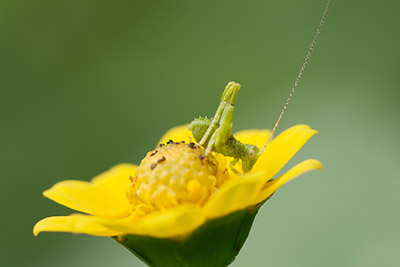

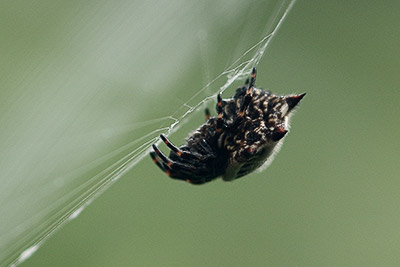
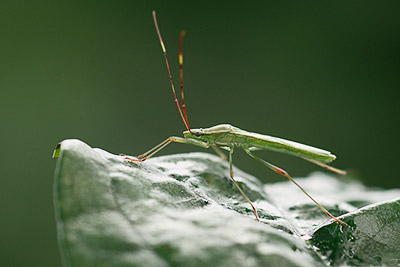
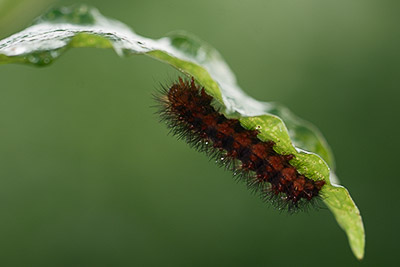
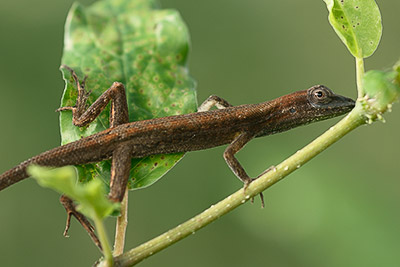
Coatimundis, a member of the raccoon family, and Agoutis, which are related to guinea pigs, are common sightings and may be the easiest animals to photograph.
Coatimundis measure 12 "-24" excluding the tail, which can be as long as their body. They meander in groups that reach a dozen or more and are very tolerant of passersby, though skittish if you make noise. Remain quiet and still. You'll be surprised how close you can get to them and how close they come to you; they'll walk right up to you if you let them. They move quickly and rarely stay put, so an auto-focus lens would prove beneficial. A 25-70mm zoom would be ideal for when they get close, and a 70-200mm for those moments when they're further away.
Agoutis, Ñeque in Spanish, are small cat-sized rodents with a uniform brown coat. They are shyer than Coatimundis, but you see them scouring the trail for food consisting of fallen fruit, leaves, and roots. A moderately fast 70-200mm should suffice. During my most recent visit, I stumbled on a large group of Agoutis scurrying along the trail near the base of Radio Hill.
If you are lucky, you might see a peccary, a black pig-like animal that travels in small groups and eats roots and grubs. Weighing 45-85 lbs, they're the largest land animal you'll likely encounter in the park and, indeed, not the most beautiful; you'll unlikely see a tapir, jaguar, or mountain lion/cougar, though I did see a tayra, which resembles a weasel, momentarily as it ran across the trail.
I've seen plenty of howler monkeys along Pipeline Road and a few white-faced capuchins, though I'm sure spider and tamarin monkeys are also present. The thundering roar of the howler monkey is omnipresent. If you walk in from the main entrance, you'll likely see or hear them before reaching the Discovery Center. Unfortunately, they mostly remain high in the canopy and never descend near the trail.
Ask any birder about Pipeline Road, and they've heard about it. And for good reason, it's a special place. The abundance and variety of bird species are impressive. Coupled with the Rainforest Discovery Center, you couldn't ask for more of a birding/nature-viewing jaunt through Panama's tropical rainforest.
Note: If you remain on the main road, mosquitoes and other insects should not pose a problem, though having insect repellent is probably a good idea. But step off the trail onto an unbeaten path, and it won't take long for them to find you.
By Bus
There are no public buses to the entrance of Pipeline Road or even Gamboa. Metro buses — Panama City's public bus system — only go as far as Summit Gardens, which resides along the same road leading to Gamboa but a considerable distance away. In my opinion, coordinating travel from Summit Gardens to Gamboa or Pipeline Road would be difficult.
However, a private mini-van service for Gamboa from the Albrook Bus Terminal exists. The buses depart from behind the chicken fast-food eatery PIO-PIO. To the right and before the eatery is an exit; you'll see public bathrooms off to the right and a row of turnstiles to the left; behind the latter are buses. To pass through the turnstiles, you will need a RAPI>PASS bus card, which you can purchase for $2.00 at the machine along the wall before reaching the turnstiles. Sometimes, officials work in the small booth adjacent to the machine, enabling you to purchase the card at the window. In addition to the card, you will need to add $1.00 to cover the terminal entrance fee, which is $0.10. The bus trip takes approximately 45 minutes, depending on traffic, and costs $2.00 per person (each way), making it, by far, the least expensive option.
Monday through Friday, the min-vans depart the Albrook Terminal @ 5:30, 8:00, 12:00, and 2:00 and return from Gamboa @ 7:00, 9:00, 1:00, and 3:00. On Saturday, they depart @ 8:00 a.m. and 2:00 p.m. There is no service on Sunday. Get off at the last bus stop on the main road (Ave. Omar Torrijos Herrera) that passes through Gamboa — it resides on a corner, and across the street, there is an abandoned basketball court. Here, the van will turn right and proceed to Gamboa Resort. If you miss the stop, you can always get off when he passes by a second time when returning to Albrook Terminal about 10-20 minutes later.
By Taxi
Another alternative would be to hire a taxi to Gamboa; most taxi drivers in Panama City will not know of Pipeline Road. Ask to be dropped off at the aforementioned bus stop and walk from there. He may be willing to take you to the entrance for an additional fee but keep in mind the road deteriorates after departing Gamboa. He might change his mind when he sees the dirt and gravel road. A fair, one-way fare to Gamboa would be around $30.00-$40.00.
By Private/Rental Vehicle
The trip from Panama City to Gamboa takes approximately 45 minutes, depending on traffic. Proceed as though you are visiting the Miraflores Locks Visitor Center; you will pass the Albrook Airport to the right and Panama Canal Railway Terminal to your left. After the visitor center, continue north as the road winds around the eastern side of Miraflores Lake. Moments before reaching Pedro Miguel Locks, the road turns left and crosses over the railroad tracks. It then turns right. Soon, you'll pass the Summit Rainforest & Golf Resort off to the right. Immediately following the coming overpass, turn left at the intersection; you will see signs pointing to Gamboa and Summit Gardens. Proceed along this two-lane road that is in dire need of repair. After crossing the newly built cement bridge spanning the Chagres River, turn left and proceed along Omar Torrijos Herrera Avenue — always stay left — until you reach the end of town.
Hotel Transportation
If you have reservations or intend to spend the evening in Gamboa, I recommend consulting with your hotel. They should be able to help coordinate your travel and provide you with free transportation.
The Walk from Gamboa to Pipeline Road
From the corner bus stop, continue straight along the cement road; do not follow the bus to the right! You'll pass a Smithsonian Institute Scientific Research Station a few hundred feet ahead and off to the right. Shortly afterward, the left side of the road opens up, enabling you to see the canal and the many maintenance installations along the channel. Continue walking until you reach an intersection. It should take at most 8-10 minutes from the bus stop.
Stay left at the intersection and continue on the asphalt road — a sign pointing to the Rainforest Discovery Center (2.4 Km).
After 4-5 minutes, the road turns to dirt and gravel and soon bends to the right. On the right side is a steel guard rail, and on the left is a railroad crossing. (If you are visiting Barro Colorado Island, cross the tracks to reach the Smithsonian Institute's boat dock.) After the bend, there is a noticeable incline, but nothing too strenuous.
Continue for another 4-5 minutes — staying left — until reaching a yellow security gate. Before the gate, turn right. There is another sign pointing to the center (2.2 Km).
Further ahead (2-3 minutes) is the entrance to Pipeline Road, marked by an abandoned ranger station. If arriving by car, there is ample space off to the right where you can park. The area is very safe. You need not worry. Pipeline Road is best suited for passenger vans, pick-ups, and SUVs, though I frequently see sedans and compact autos.
You can also park your vehicle inside the park along the main road, across from the entrance to the Rainforest Discovery Center. Or further down the road before the abandoned ranger station/gate. The parking lot in front of the visitor center is reserved only for paying customers.
rainforest discovery center pipeline road soberania national park panama
I'm unsure if cruise ships offer an excursion to the Rainforest Discovery Center, a low-impact eco-tour near the Gamboa Resort, not far from where boat tours to Monkey Island depart and the Aerial Tram is situated. I decided to add it to the excursion list for the 2023/24 cruise ship season in the event.
The Rainforest Discovery Center borders Soberania National Park and resides just off Panama's famous Pipeline Road — approximately 1 mile (1.6 km) from the park entrance. Whether you're a birder or just looking for a bird's-eye view of the rainforest canopy, the Rainforest Discovery Center is a great place to visit.
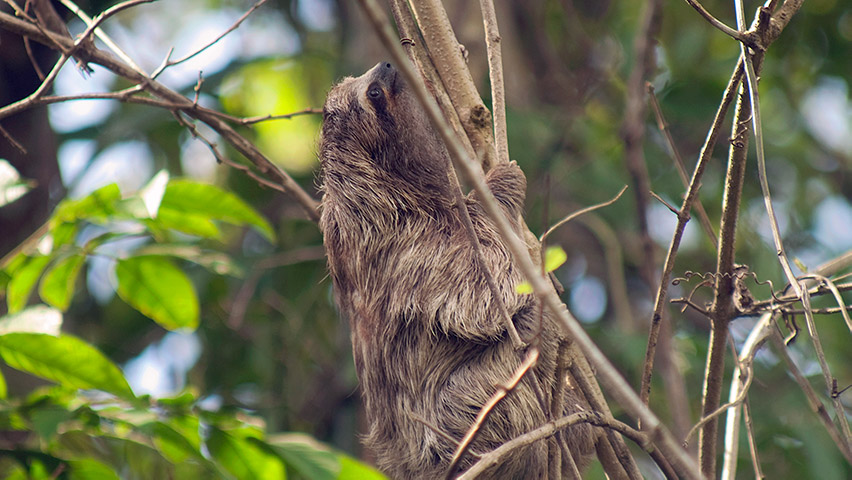
Rainforest Discovery Center – A resident sloth, doing what they do best — hanging out! He was relatively low in a tree behind the main center's viewing platform. Thankfully, the guide pointed him out to me; I would never have noticed it was there.
The Center consists of an open main building with hummingbird feeders surrounded by lush, verdant rainforest, a 105 ft. (32m) birdwatching observation tower — the only one in Panama City — and a circuit of low-impact trails that are easy to follow and navigate. One of the trails, the longest of the three, leads to Lake Calamito.
The path to the main building begins on a wooden ramp, which quickly turns to a gravel path. It passes underneath the building's leading edge and hummingbird feeders; you enter on the left side towards the back.
As you can see, the open patio is primarily wood and very rustic in appearance but comfortable and suitable. Around its perimeter is a sturdy handrail, and the simple wooden stools and tables provide plenty of room to relax and observe flora and fauna. In addition, there are two clean, private bathrooms with running water. Coffee is the only refreshment offered; there are no snacks. Overall, the atmosphere is pleasant and comfortable, and coffee is available.
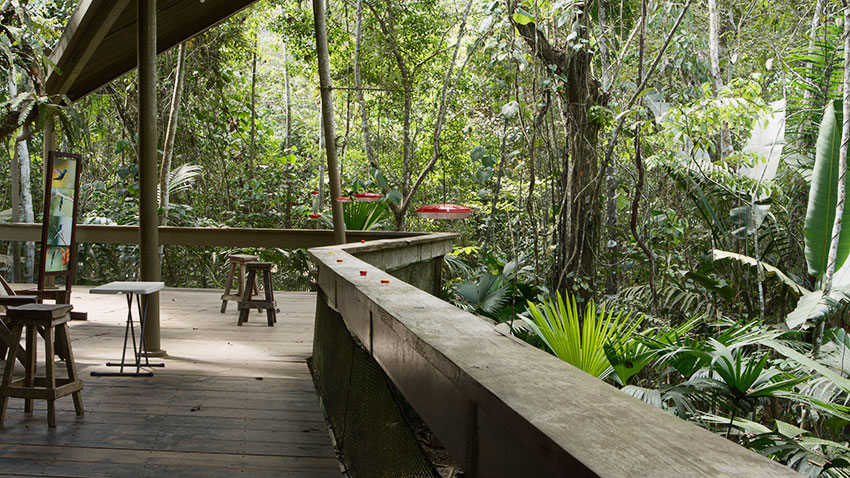
Along the open edge, facing north/northwest, are several hummingbird feeders, so you should see various species when in season. And if that's not enough, the guides place small feeding dishes atop the handrail.
The feeders and the foliage nearest the building remain unlit or dimly lit until late afternoon, though rays of light streak through gaps in the roof for short periods, offering some relief. Only in the afternoon does more direct sunlight reach the feeders. It's something to remember if you intend to photograph them; a flash would be helpful under most circumstances. The hummingbirds should be sunlit and much easier to photograph when perched on branches further out. I captured these hummingbird pictures when they were resting out front.
There is quite a bit of open space between the handrail and the rainforest. For that reason, a long lens is helpful when photographing hummingbirds or other bird species resting on branches and tree limbs.
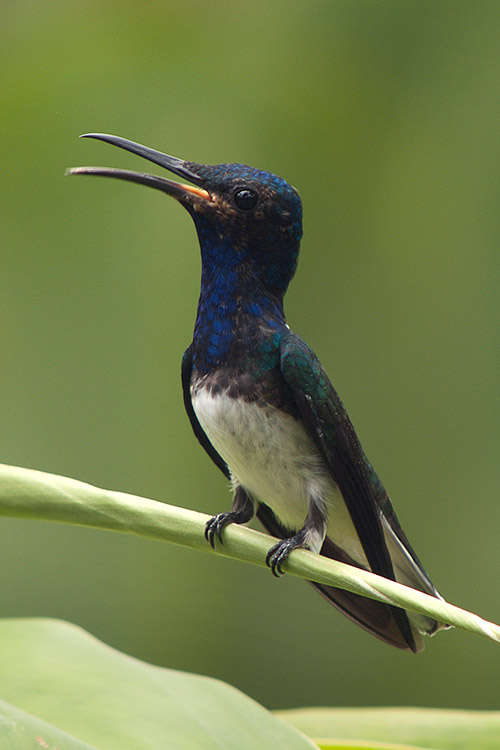
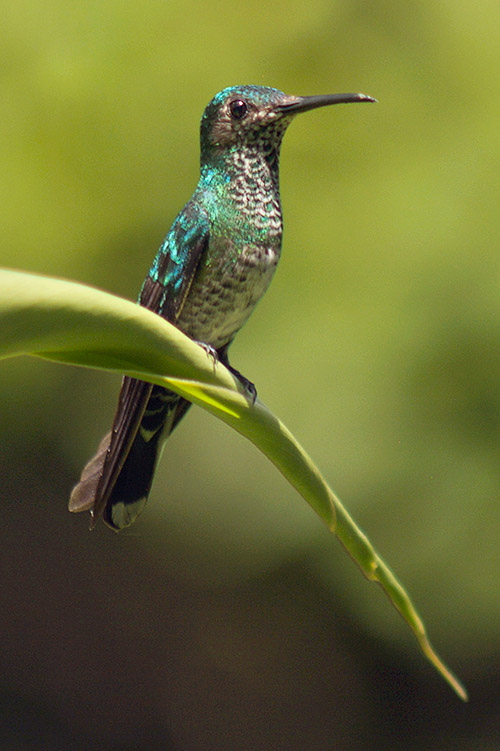
Across from the entrance to the main building is the path leading to the observation platform. It is a downhill walk on a predominantly paved road. The steel staircase is off to the right; you can't miss it! Here is what it looks like. It's only 165 ft (50 m) from the staircase to the platform's base, along a sturdy wooden path with metal mesh strips that ensure proper footing.
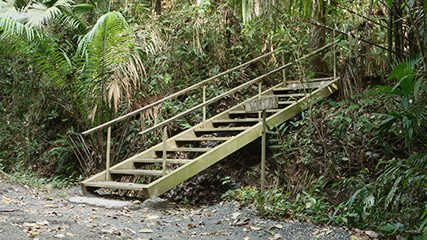
Towering 105 ft., the observation platform is a visually attractive structure consisting of a spiral staircase with 174 stairs and four platforms providing panoramic views of the surrounding forest. Home to an impressive collection of birds and animal species, it is ideal for birders and nature lovers and is best enjoyed early morning or late afternoon.
Its uppermost platform clears the canopy and provides panoramic views of the surrounding forest and, to the west, Lake Calamito. There is 4-5 ft. of walking space between the platform's outer railing and the wooden bench that rests along its inner perimeter. It is open — no awning or roofing — and you can walk and settle anywhere you like. The perimeter handrail measures approximately 4ft in height and has mesh netting around the perimeter.
To the north and west, the forest is nearby and, in some areas, has overgrown the tower. To the east and south, it's more open, and the canopy never nears or clears the platform.
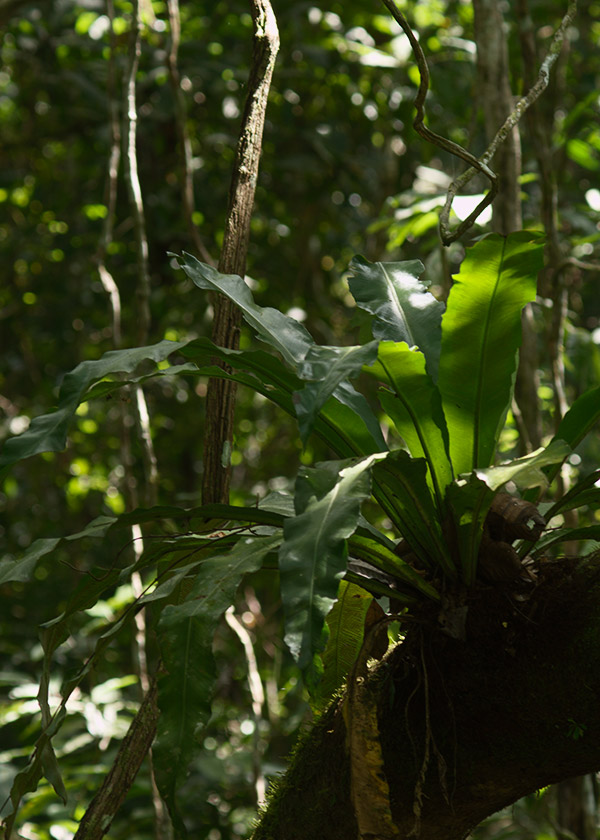
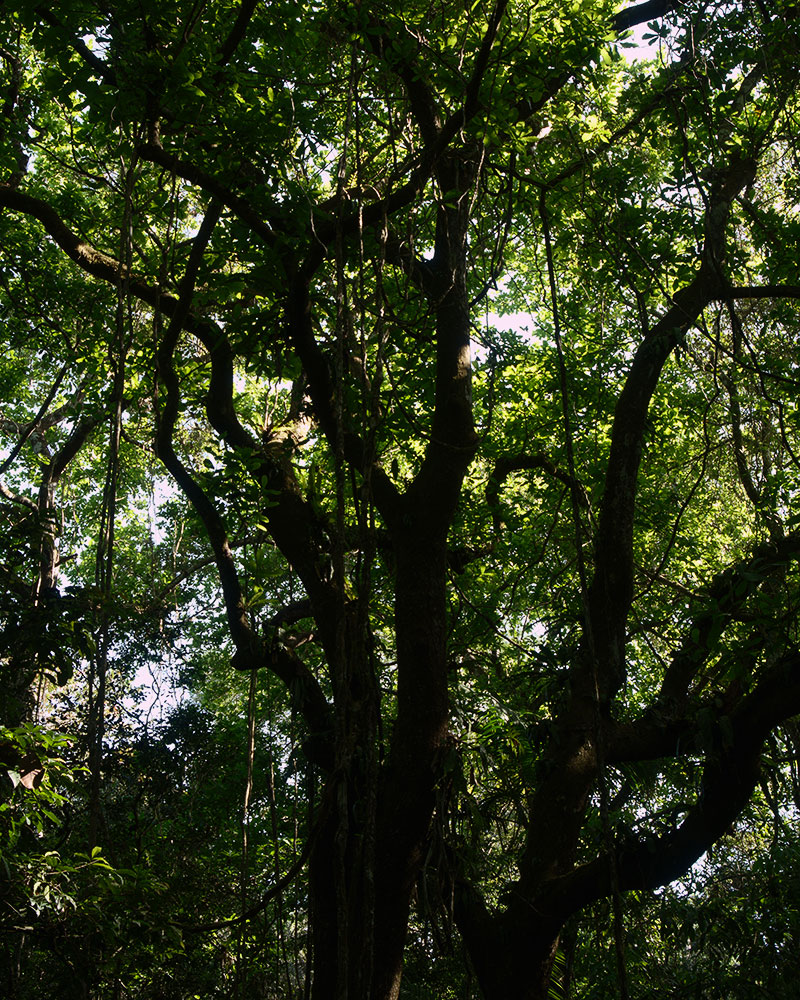
Observation Platforms — While the top platform is open, broad, and spacious, the three lower platforms surrounding the staircase offer limited movement. And because the tower narrows as you ascend, the available space lessens on each subsequent platform. The first and second platforms have enough space to walk around, but the third, the last before reaching the top, is tight. But unlike the uppermost platform, they provide unobstructed views of the canopy's underlying growth. There are some fantastic photographic opportunities here, with light rays piercing through the canopy. It's a great place to see Morpho butterflies and monkeys. I don't know of another location along Pipeline Road that offers a similar view.
The staircase and perimeter surrounding all four platforms have mesh netting and metal handrails. While the staircase's width remains the same throughout, it is unsuited for two-way foot traffic, so if you see or hear others making their way, I suggest you stay on one of the platforms and let them pass. When you exit the staircase at the top, you'll look north/northwest.

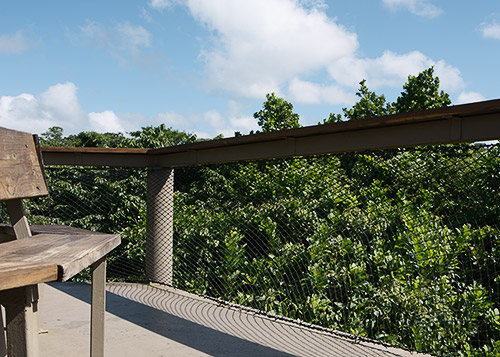
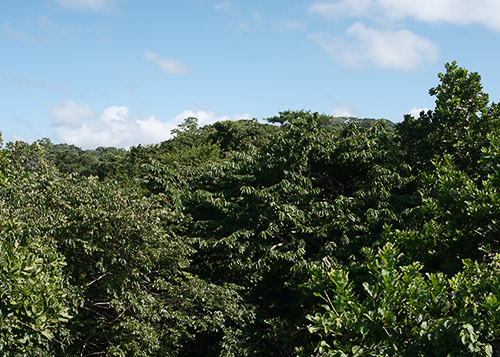
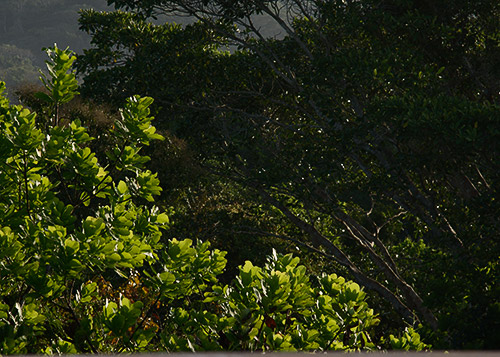
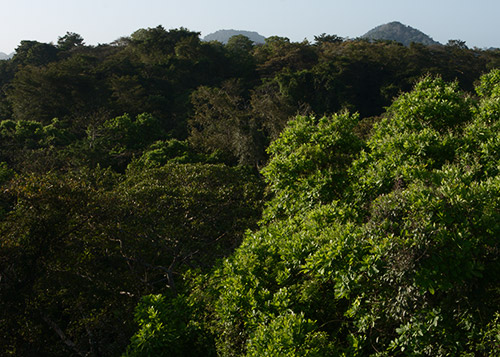
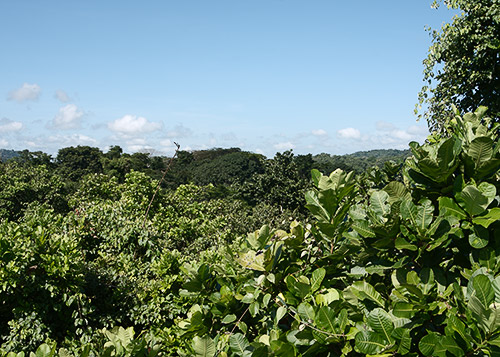
Unfortunately, the tower is not as sturdy as expected or would have liked and is not well suited for videography, time-lapses, or telescopes. For still photographs or general viewing purposes, you shouldn't be bothered. The structure is very safe, so you need not be concerned for your safety. It is a design flaw. The tower is surprisingly narrow, even at its base. The slightest movement causes it to sway. A single person walking up or down the stairs or moving from one side of a platform to another is enough. The more people, the more noticeable it becomes. Honestly, it can be frustrating at times.
A 70-200mm lens will suffice when the hummingbirds feed at the designated feeders. They can be a bit skittish but have grown accustomed to people, though I found them uneasy with the sound of the shutter. Remember to move slowly and remain quiet. If you have a cable release or wireless trigger, it's even better. This way, you can stay further away to lessen the disturbance.
A better, more natural setting to photograph them is when they rest on the branches, twigs, and vines further away, 10-20 feet from the feeders. For those instances, a 300mm+ lens would be helpful, and a tripod is necessary if your camera or lens does not incorporate a vibration reduction feature. Catching them on the fly is no easy task, but possible with patience, persistence, and the right gear. Good luck! I'll keep trying.
During two recent visits, I saw sloths close to the main building, to the left, and behind the patio. Sometimes, they are out in the open — other times, buried high in the dense canopy. As always, it's a matter of luck. When the guides see them, they will point them out.
Anything from a wide-angle to a long telephoto lens will do when on the observation tower. The birds-eye view of the dense rainforest delivers terrific scenic photographic opportunities. When photographing animals, you'll find a long zoom lens is more beneficial than a prime. Unless you arrive extremely early, there is usually enough light, even for a moderately fast lens. There is no need for an f/2.8 when shooting from the observation tower.
The Rainforest Discovery Center consists of three trails. The two longest trails share a gravel/dirt base for easy walking. In most places, the trails are bordered on both sides by wooden slabs or tree trunks, making them easy to follow. They are relatively flat but include several staircases.
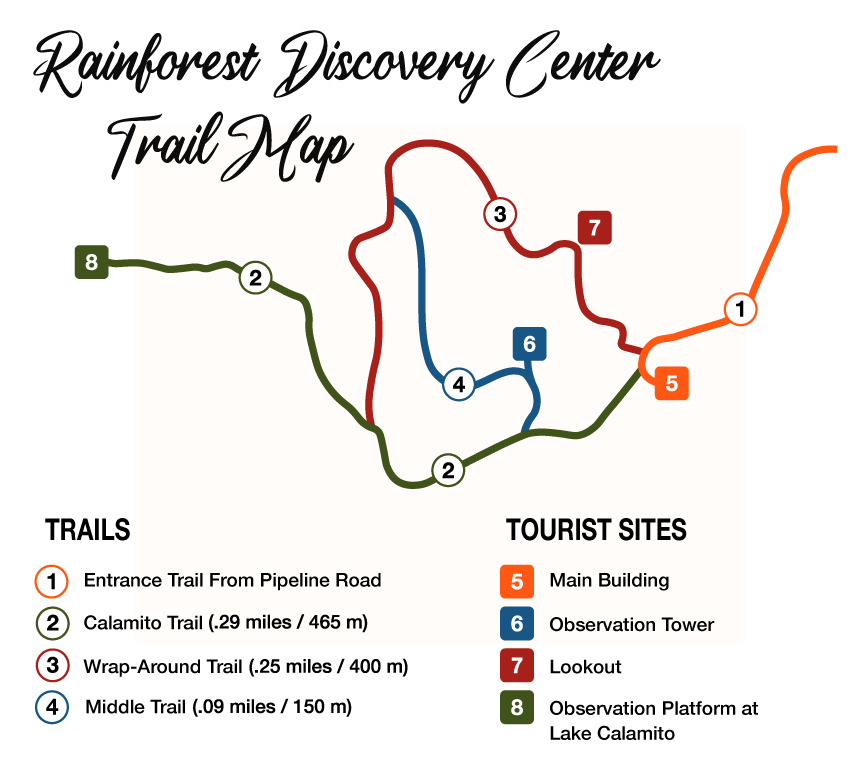
Measuring .29 miles (465 m), the first and longest of the three departs from in front of the main building, passes the steel staircase leading to the observation tower, and concludes at the observation platform overlooking Lake Calamito. It's the best, maybe even the only, place to see aquatic birds like Herons, Snail Kites, Caracaras, and Cormorants up close. There is a wooden wrap-around bench where you can sit down. I took this picture from the platform.
At the midway point on this trail is an intersection leading to a second, slightly shorter trail, measuring .25 miles (400m). It wraps around the observation tower and intersects with the entrance road to the left and a short distance from the main building. There is a designated lookout area with a bench, but the views from the observation tower's many platforms are much better.
The shortest trail measures only .09 miles (150 m) and connects the previously mentioned trails. Traversing north/south, it intersects the pathway leading to the observation tower near its base and the second trail near its northernmost part. Unlike the others, this trail forms a peak and has a natural footing. You won't find a gravel base, steps, or rigid wooden boundaries, making it less low-impact friendly.
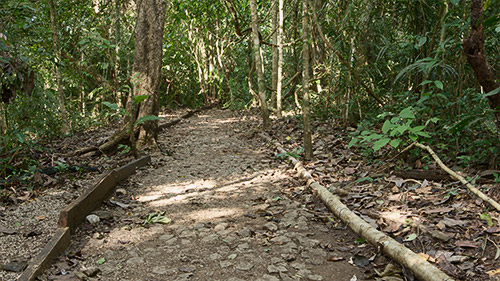
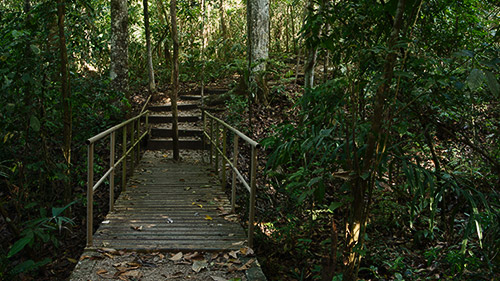
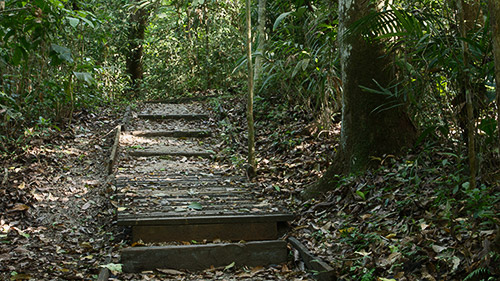

In summary, the Rainforest Discovery Center is a great place to visit. It is home to an impressive collection of birds and animal species and is ideal for birders and nature lovers. The combination of an observation tower, hummingbird feeders, and a circuit of trails makes it well worth the price of admission. You need not worry about mosquitoes and other insects at the main center, on the trails, or atop the observation tower — they should not pose a problem, though having insect repellent is probably a good idea. But step off the trail onto an unbeaten path, and it won't take long for them to find you.